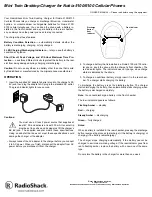
Section 4A: Safety
206
to the FCC’s attention by contacting the FCC RF Safety Program at: 202-418-2464
or by email:
.
Does the FCC maintain a database that includes information on the location
and technical parameters of all the transmitting towers it regulates?
Each of the FCC Bureaus maintains its own licensing database system for the
service(s) it regulates (e.g., television, cellular service, satellite earth stations.)
The FCC issues two types of licenses: site specific and market based. In the case
of site specific licensed facilities, technical operating information is collected
from the licensee as part of the licensing process. However, in the case of
market based licensing (e.g., PCS, cellular), the licensee is granted the authority
to operate a radio communications system in a geographic area using as many
facilities as are required, and the licensee is not required to provide the FCC with
specific location and operating parameters of these facilities.
Information on site specific licensed facilities can be found the “General Menu
Reports” (GenMen) at
http://gullfoss2.fcc.gov/cgi-bin/ws.exe/genmen/index.hts
.
The various FCC Bureaus also publish on at least a weekly basis, bulk extracts of
their licensing databases. Each licensing database has its own unique file
structure. These extracts consist of multiple, very large files. The FCC’s Office of
Engineering and Technology (OET) maintains an index to these databases at
http://www.fcc.gov/oet/info/database/fadb.html
. Entry points into the various
databases include frequency, state/county, latitude/longitude, call-sign and
licensee name. For further information on the Commission’s existing databases,
you can contact Donald Campbell at
or 202-418-2405.
Can local and state governmental bodies establish limits for
RF exposure?
Although some local and state governments have enacted rules and regulations
about human exposure to RF energy in the past, the Telecommunications Act of
1996 requires the Federal Government to control human exposure to RF
emissions. In particular, Section 704 of the Act states that, “No State or local
government or instrumentality thereof may regulate the placement,
construction, and modification of personal wireless service facilities on the
basis of the environmental effects of radio frequency emissions to the extent
that such facilities comply with the Commission’s regulations concerning such
emissions.” Further information on federal authority and FCC policy is available
in a fact sheet from the FCC’s Wireless Telecommunications Bureau at
www.fcc.gov/wtb
.
Do wireless phones pose a health hazard?
The available scientific evidence does not show that any health problems are
associated with using wireless phones. There is no proof, however, that wireless
phones are absolutely safe. Wireless phones emit low levels of radiofrequency
energy (RF) in the microwave range while being used. They also emit very low
levels of RF when in the stand-by mode. Whereas high levels of RF can produce
health effects (by heating tissue), exposure to low level RF that does not
Summary of Contents for SCP-2300
Page 1: ...User sGuide SanyoSCP 2300 www qwestwireless com ...
Page 11: ...Section 1 Getting Started ...
Page 17: ...Section 2 Your Phone ...
Page 153: ...Section 3 Qwest Service Features ...
Page 200: ...Section 4 Safety Guidelines ...













































